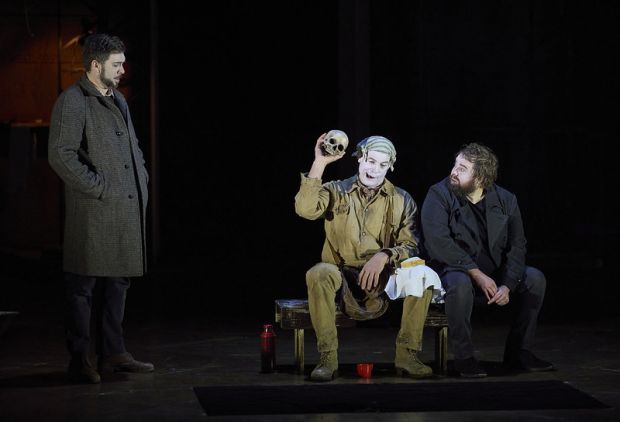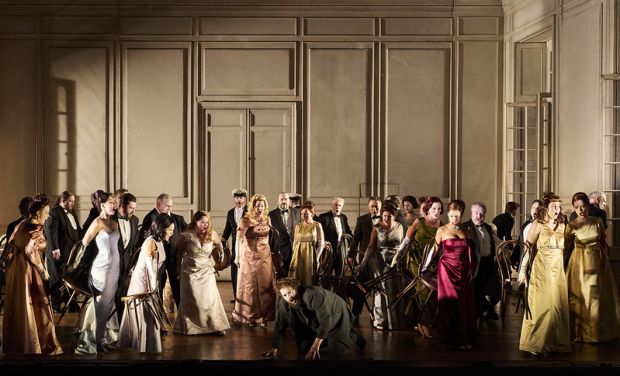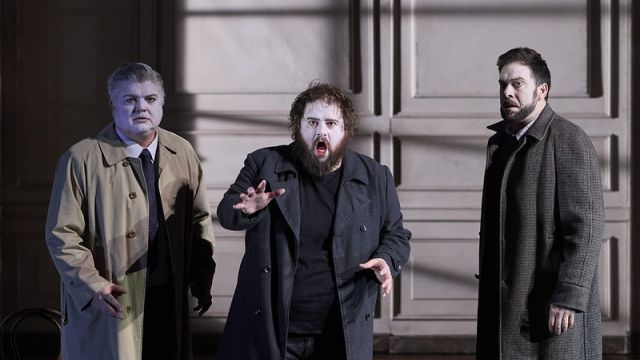Hamlet
This is a bone chillingly brilliant production which surrounds the audience in sound, and takes them deep into the psyche of Shakespeare’s most famous character.
You won’t leave the opera whistling the tunes, but you will not forget the haunting narrative, which amidst the carnage also has surprising elements of humour.
The opera had its world premiere at the Glyndebourne Festival in 2017 and has since had productions at the New York Met, several in Germany and Adelaide Festival.
This production in Sydney makes it one of the most successful operas composed by an Australian composer.

Prince Hamlet (Allan Clayton) opens the opera by reciting half of his most famous phrase: “Or not to be”. Then the stage opens to a grand reception for his mother Gertrude (Catherine Carby), who has married his uncle Claudius (Rod Gilfry) the new King.
The detailed orchestration and chorus music is thrilling. Singers and instruments are not just on the stage or in the pit but planted high up in the top tier of seats next to the stage.
Brett Dean composes with the keenest of ear for the mood of the story.
Hamlet’s depression at the death of his father, and suspicion that something is rotten in the state of Denmark, is reflected in the slightly menacing tone of the score during the opening chorus.
The entrance of the ghost of Old King Hamlet, to urge his son to avenge his murder, has a haunting gothic horror sound. The sound effects combine beautifully with spooky lighting, the hulk like bare chest and white make-up that splatter Jud Arthur.
The characters of Rosencrantz and Guildenstern are written with comic effect – their songs are in the falsetto range, allowing Russell Harcourt and Christopher Lowrey to twitter like birds.
Ophelia’s collapse into hysteria has a suitable ethereal quality and was spectacularly sung and performed by Lorina Gore.

When Hamlet’s complete descent into despair towards the end of the opera arrives, the music has a menacing atonal quality. It reflects a notion that he is barely able to function.
Librettist Matthew Jocelyn sprinkles moments of levity through the piece. Actors in a troupe preparing to put on a play to trap Claudius, jumble and make fun of Hamlet’s most famous soliloquy.
Likewise, the gravedigger scene where Hamlet addresses the skull of his friend Yorick has wit and clarity.
The set by Ralph Myers and costumes by Alice Babidge had a modern sensibility, which is consistent with the contemporary sound. The high wall interior of the palace impressively breaks up and revolves to move between the different acts.

The original play has several editions which can run as long as four hours. The Director Neil Armfield noted in the pre-performance talk that adapting the text into an opera that goes for just 3 hours and 20 minutes, including interval, allowed for the important scenes to stay in the opera.
There is a never a dull moment in this opera which reaches a swashbuckling and bloody conclusion. Allan Clayton, who has played the role in all four productions, gives a mighty performance as flights of angels sing him to his rest.
David Spicer
Photographer: Keith Saunders
Subscribe to our E-Newsletter, buy our latest print edition or find a Performing Arts book at Book Nook.

